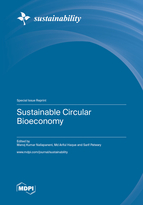Sustainable Circular Bioeconomy
A special issue of Sustainability (ISSN 2071-1050). This special issue belongs to the section "Bioeconomy of Sustainability".
Deadline for manuscript submissions: closed (30 September 2022) | Viewed by 51804
Special Issue Editors
Interests: building-integrated photovoltaics; circular economy; sustainability and resilience; energy management; life cycle assessment; technoeconomic analysis; modeling and performance investigation of energy systems; solar for smart cities applications; advances in solar energy installations; microgrids; blockchain technology; Internet of Things
Special Issues, Collections and Topics in MDPI journals
Interests: biomass; waste valorization; fermentation; metabolic engineering; biorefinery and life cycle analysis
Special Issue Information
Dear Colleagues,
As we all know, when the bioeconomy was first explored, for many, it was simply a case of switching fossil resources to renewables and other naturally derived resources (Tan and Lamers, 2021). However, now, with the current phase of technological development and innovation, the bioeconomy is going beyond what was previously projected and is currently fostering growth and development in new and emerging economies, in order to become more sustainable. At the same time, it is believed that the bioeconomy ensures continuous resource and service functions from natural assets, resulting in a circular bioeconomy concept. However, given the existing limitations (e.g., rebound effects) and complexities (e.g., low-carbon energy inputs, sustainable supply chains, and synergies and conflicts with broader ecological processes and ecosystem services) in the circular economy and bioeconomy, as well as their intersections, the circular bioeconomy concept cannot necessarily deliver its perceived sustainability benefits (D'Amato et al., 2017; Kirchherr et al., 2017; Korhonen et al. 2018). There could be numerous reasons for this, which could vary from case to case. Therefore, this Special Issue invites contributions focusing on multiple sectors that:
- Critically examine the existence of circular bioeconomy, identify its challenges, and understand why sustainability benefits are not perceived;
- Logically show the conceptual or implemented models and tools used to evaluate sustainability benefits;
- Clearly demonstrate the resource efficiency and sustainability (economic, environmental, and social) of circular bioeconomy concepts.
The focused sectors include energy; agriculture; forestry; fishing and aquaculture; manufacturing of food, beverages and tobacco; manufacturing of bio-based textiles; manufacturing of wood products and furniture, manufacturing of paper; manufacturing of bio-based chemicals, pharmaceuticals, plastics, and rubber; manufacturing of liquid biofuels; production of bioelectricity; and others.
References:
D'Amato, D., Droste, N., Allen, B., Kettunen, M., Lähtinen, K., Korhonen, J. et al. (2017). Green, circular, bio economy: a comparative analysis of sustainability avenues. J. Clean. Prod. 168, 716–734.
Kirchherr, J., Reike, D., and Hekkert, M. (2017). Conceptualizing the circular economy: an analysis of 114 definitions. Resour. Conserv. Recycling 127, 221–232.
Korhonen, J., Nuur, C., Feldmann, A., and Birkie, S. E. (2018). Circular economy as an essentially contested concept. J. Clean. Prod. 175, 544–552.
Tan E.C.D., and Lamers P. (2021). Circular bioeconomy concepts—a perspective. Front. Sustain. 2, 701509.
Dr. Manoj Kumar Nallapaneni
Dr. Md Ariful Haque
Dr. Sarif Patwary
Guest Editors
Manuscript Submission Information
Manuscripts should be submitted online at www.mdpi.com by registering and logging in to this website. Once you are registered, click here to go to the submission form. Manuscripts can be submitted until the deadline. All submissions that pass pre-check are peer-reviewed. Accepted papers will be published continuously in the journal (as soon as accepted) and will be listed together on the special issue website. Research articles, review articles as well as short communications are invited. For planned papers, a title and short abstract (about 100 words) can be sent to the Editorial Office for announcement on this website.
Submitted manuscripts should not have been published previously, nor be under consideration for publication elsewhere (except conference proceedings papers). All manuscripts are thoroughly refereed through a single-blind peer-review process. A guide for authors and other relevant information for submission of manuscripts is available on the Instructions for Authors page. Sustainability is an international peer-reviewed open access semimonthly journal published by MDPI.
Please visit the Instructions for Authors page before submitting a manuscript. The Article Processing Charge (APC) for publication in this open access journal is 2400 CHF (Swiss Francs). Submitted papers should be well formatted and use good English. Authors may use MDPI's English editing service prior to publication or during author revisions.
Keywords
- circular bioeconomy
- circular economy
- bioeconomy
- waste management
- industrial ecology
- environmental services
- recycling, reuse, regeneration and recovery
- bioconversion methods
- biomass valorization
- food–feed–fuel
- circular business models
- value-added products
- techno-economic feasibility
- life cycle assessment
- tools for sustainability








